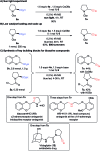Room temperature decarboxylative cyanation of carboxylic acids using photoredox catalysis and cyanobenziodoxolones: a divergent mechanism compared to alkynylation
- PMID: 28451301
- PMCID: PMC5396527
- DOI: 10.1039/c6sc04907a
Room temperature decarboxylative cyanation of carboxylic acids using photoredox catalysis and cyanobenziodoxolones: a divergent mechanism compared to alkynylation
Abstract
The one-step conversion of aliphatic carboxylic acids to the corresponding nitriles has been accomplished via the merger of visible light mediated photoredox and cyanobenziodoxolones (CBX) reagents. The reaction proceeded in high yields with natural and non-natural α-amino and α-oxy acids, affording a broad scope of nitriles with excellent tolerance of the substituents in the α position. The direct cyanation of dipeptides and drug precursors was also achieved. The mechanism of the decarboxylative cyanation was investigated both computationally and experimentally and compared with the previously developed alkynylation reaction. Alkynylation was found to favor direct radical addition, whereas further oxidation by CBX to a carbocation and cyanide addition appeared more favorable for cyanation. A concerted mechanism is proposed for the reaction of radicals with EBX reagents, in contrast to the usually assumed addition elimination process.
Figures









Similar articles
-
Decarboxylative Alkynylation and Cyanation of Carboxylic Acids using Photoredox Catalysis and Hypervalent Iodine Reagents.Chimia (Aarau). 2017 Apr 26;71(4):226-230. doi: 10.2533/chimia.2017.226. Chimia (Aarau). 2017. PMID: 28446341
-
Room-temperature decarboxylative alkynylation of carboxylic acids using photoredox catalysis and EBX reagents.Angew Chem Int Ed Engl. 2015 Sep 14;54(38):11200-4. doi: 10.1002/anie.201505111. Epub 2015 Jul 24. Angew Chem Int Ed Engl. 2015. PMID: 26212356
-
Decarboxylative alkynylation and carbonylative alkynylation of carboxylic acids enabled by visible-light photoredox catalysis.Angew Chem Int Ed Engl. 2015 Sep 14;54(38):11196-9. doi: 10.1002/anie.201504559. Epub 2015 Jul 6. Angew Chem Int Ed Engl. 2015. PMID: 26149104
-
Alkynylation of radicals: spotlight on the "Third Way" to transfer triple bonds.Chem Sci. 2019 Aug 13;10(39):8909-8923. doi: 10.1039/c9sc03033f. eCollection 2019 Oct 21. Chem Sci. 2019. PMID: 31762975 Free PMC article. Review.
-
Cyanation with isocyanides: recent advances and perspectives.Chem Commun (Camb). 2024 Feb 6;60(12):1546-1562. doi: 10.1039/d3cc05880h. Chem Commun (Camb). 2024. PMID: 38240334 Review.
Cited by
-
Preparation, structure, and reactivity of bicyclic benziodazole: a new hypervalent iodine heterocycle.Beilstein J Org Chem. 2018 May 8;14:1016-1020. doi: 10.3762/bjoc.14.87. eCollection 2018. Beilstein J Org Chem. 2018. PMID: 29977373 Free PMC article.
-
Organic Dye Photocatalyzed Synthesis of Functionalized Lactones and Lactams via a Cyclization-Alkynylation Cascade.Org Lett. 2024 May 24;26(20):4235-4239. doi: 10.1021/acs.orglett.4c01078. Epub 2024 May 13. Org Lett. 2024. PMID: 38739856 Free PMC article.
-
Practical Synthesis of 2-Iodosobenzoic Acid (IBA) without Contamination by Hazardous 2-Iodoxybenzoic Acid (IBX) under Mild Conditions.Molecules. 2021 Mar 27;26(7):1897. doi: 10.3390/molecules26071897. Molecules. 2021. PMID: 33801611 Free PMC article.
-
Photoinduced inverse Sonogashira coupling reaction.Chem Sci. 2022 May 30;13(25):7475-7481. doi: 10.1039/d2sc01933g. eCollection 2022 Jun 29. Chem Sci. 2022. PMID: 35872819 Free PMC article.
-
Copper-catalyzed aminoalkynylation of alkenes with hypervalent iodine reagents.Chem Sci. 2017 Dec 1;8(12):8265-8270. doi: 10.1039/c7sc03420b. Epub 2017 Oct 16. Chem Sci. 2017. PMID: 29568474 Free PMC article.
References
-
- Rappoport Z., Chemistry of the Cyano Group, Wiley, London, 1970.
- Fleming F. F. Nat. Prod. Rep. 1999;16:597.
- Enders D., Shilvock J. P. Chem. Soc. Rev. 2000;29:359.
- Fleming F. F., Wang Q. Z. Chem. Rev. 2003;103:2035. - PubMed
- Murphy S. T., Case H. L., Ellsworth E., Hagen S., Huband M., Joannides T., Limberakis C., Marotti K. R., Ottolini A. M., Rauckhorst M., Starr J., Stier M., Taylor C., Zhu T., Blaser A., Denny W. A., Lu G.-L., Smaill J. B., Rivault F. Bioorg. Med. Chem. Lett. 2007;17:2150. - PubMed
- Kim J., Kim H. J., Chang S. Angew. Chem., Int. Ed. 2012;51:11948. - PubMed
- Wang T., Jiao N. Acc. Chem. Res. 2014;47:1137. - PubMed
- Ping Y., Ding Q., Peng Y. ACS Catal. 2016;6:5989.
-
- Nabholtz J. M., Buzdar A., Pollak M., Harwin W., Burton G., Mangalik A., Steinberg M., Webster A., von Euler M. J. Clin. Oncol. 2000;18:3758. - PubMed
- Augeri D. J., Robl J. A., Betebenner D. A., Magnin D. R., Khanna A., Robertson J. G., Wang A. Y., Simpkins L. M., Taunk P., Huang Q., Han S. P., Abboa-Offei B., Cap M., Xin L., Tao L., Tozzo E., Welzel G. E., Egan D. M., Marcinkeviciene J., Chang S. Y., Biller S. A., Kirby M. S., Parker R. A., Hamann L. G. J. Med. Chem. 2005;48:5025. - PubMed
- Gauthier J. Y., Chauret N., Cromlish W., Desmarais S., Duong L. T., Falgueyret J. P., Kimmel D. B., Lamontagne S., Leger S., LeRiche T., Li C. S., Masse F., McKay D. J., Nicoll-Griffith D. A., Oballa R. A., Palmer J. T., Percival M. D., Riendeau D., Robichaud J., Rodan G. A., Rodan S. B., Seto C., Therien M., Truong V. L., Venuti M. C., Wesolowski G., Young R. N., Zamboni R., Black W. C. Bioorg. Med. Chem. Lett. 2008;18:923. - PubMed
LinkOut - more resources
Full Text Sources
Other Literature Sources

